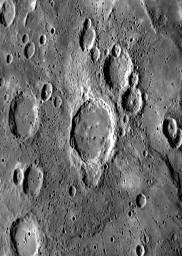Crater Ejecta and Chains of Secondary Impacts
Caption:
This newly observed flat-floored crater was viewed at an oblique angle as MESSENGER approached Mercury for its third flyby, about two hours from closest approach. This crater is younger than nearby craters of similar size, indicated by the distinctive halo of small secondary craters that radiate outward from the central structure. Many of these secondaries are aligned in chain-like formations and some show characteristic "herringbone" features pointing back to the crater of origin. Crater chains are just one of many ejecta types observed on Mercury. Other ejecta features include distinct
continuous ejecta
and
crater rays
, which are composed of both ejecta and secondaries. Another ejecta feature of note in this mosaic of two images is a zone of lighter terrain extending a bit west of north from the crater itself, possibly providing information about the direction of impact. This unnamed crater is partially superposed on an older and smaller crater to the south.
Date Acquired:
September 29, 2009
Image Mission Elapsed Time (MET):
162744204 and 162744231
Instrument:
Narrow Angle Camera (NAC) of the Mercury Dual Imaging System (MDIS)
Resolution:
600 meters/pixel (0.36 miles/pixel)
Scale:
The crater at the center of this image is about 134 kilometers (80 miles) in diameter
Spacecraft Altitude:
23,300 kilometers (14,000 miles)
Background Info:
These images are from MESSENGER, a NASA Discovery mission to conduct the first orbital study of the innermost planet, Mercury. For information regarding the use of images, see the MESSENGER
image use policy
.
Cataloging Keywords:
| Name |
Value |
Additional Values |
| Target |
Mercury |
|
| System |
|
|
| Target Type |
Planet |
|
| Mission |
MESSENGER |
|
| Instrument Host |
MESSENGER |
|
| Host Type |
Orbiter |
|
| Instrument |
Mercury Dual Imaging System (MDIS) |
|
| Detector |
Narrow Angle Camera (NAC) |
|
| Extra Keywords |
Crater, Grayscale, Impact |
| Acquisition Date |
|
| Release Date |
2009-10-01 |
| Date in Caption |
2009-09-29 |
|
| Image Credit |
NASA/Johns Hopkins University Applied Physics Laboratory/Carnegie Institution of Washington |
| Source |
photojournal.jpl.nasa.gov/catalog/PIA12271 |
| Identifier |
PIA12271 |

 Planetary Data System
Planetary Data System
